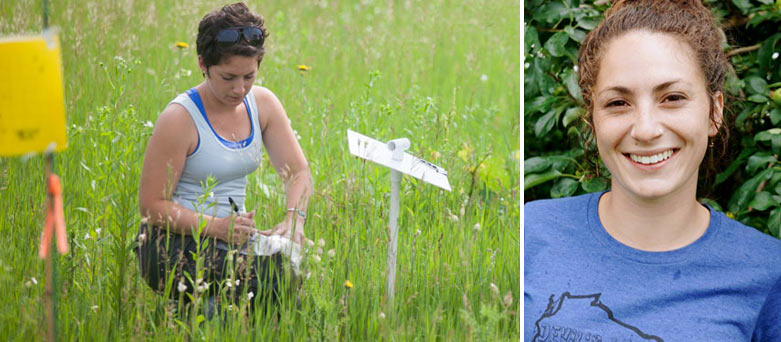
On the outskirts of farming fields you’ll often see little strips of unkempt land. These agricultural edges might have once been sown with corn or soybeans, but are now considered too hilly and so have become littered with fallen trees. Unreachable by modern farming equipment, these hard-to-reach places are usually left uncultivated each season.
But what if these marginal lands could be used to improve plant and animal diversity, while providing harvest material for energy production? What if these lands could also offer testing grounds for those who study bee and other pollinator populations?
Kiley Friedrich is a graduate student at the University of Wisconsin–Madison and researcher at the Great Lakes Bioenergy Research Center (GLBRC) who is teaming up with farmers, conservationists, and scientists from across the country to address these questions and more. With research funded by the USDA, this team of collaborators is looking to discover how to make these marginal lands useful to the farmers, animals, and insects that call them home.
One of these partners, FDC Enterprises, Inc., is a bioenergy company that harvests grasslands for biofuel production. Their mission includes turning these typically fallow farmlands into economic benefits to farmers while creating a market for their harvests by establishing business relationships with refineries.
Another partner, the non-profit conservation organization Pheasants Forever, wants to create a habitat that allows pheasants to flourish in natural settings. For these sociable game birds to experience a surge in population, however, their natural prey, including bees and other insects, need a boost.
“The bigger goal for USDA is to use a novel management tactic when dealing with these marginal lands,” says Friedrich. “This experiment is a great opportunity to show policymakers and agency professionals how industry can work with conservationists and scientists to provide better outcomes for everyone.”
FDC Enterprises is enlisting hundreds of acres of land in Virginia to serve as the testing grounds for three different kinds of borderlands: low-diversity, prairie-like habitats with up to ten species of plants, high-diversity prairies with up to 50 species of plants, and unseeded land to serve as the control. The team wants to find out if either of the two planted habitat borders serves any of the parties involved: the farmers, the pollinators, the pheasant protectors, and the biofuel producers.
Why Virginia? Well, at the end of the season, FDC Enterprises will harvest the grasses for processing into bioenergy. They chose land in the Old Dominion State because of its proximity to bioenergy processing facilities — less distance to travel means less money to spend getting the biomass to the processor. But Virginia also has the logistical advantage of being close to D.C., and to the USDA’s federal offices.
Friedrich’s interest in the research also happens to be personal – her aunt and uncle own an apple orchard in Prairie du Chien.
“My family has sometimes rented bees from across the country,” says Friedrich. “They get shipped to farms for short bouts of time and hopefully they go to the blossoms and do their jobs.”
After citing the recent steep decline in bee populations as a major concern to fruit farmers, Friedrich says there’s potentially light at the end of the tunnel.
“Hopefully, a more robust habitat on the margins of these farms will result in a more diverse and stable pollinator population across the landscape - a land management strategy that could be replicated in places like Wisconsin,” she says. “By providing a consistent habitat for pollinators in marginal lands, we hope to increase resistance by these populations to the dangers they currently face.”
This could mean a consistent and more sustainable supply of bioenergy, a better habitat for wildlife, and even a steadier source pollination services across the country for years to come.